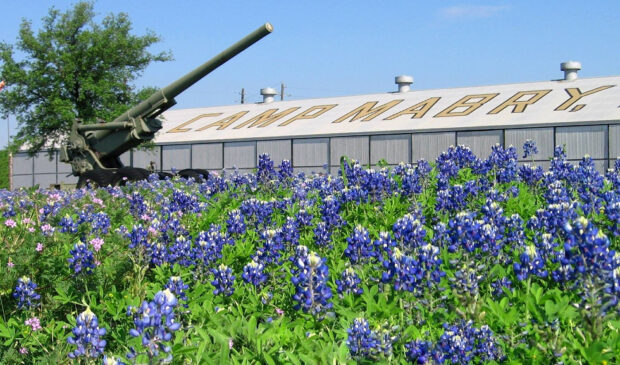
Wednesday, August 28, 2024 by Chad Swiatecki
Renowned author and journalist Lawrence Wright has unveiled his vision to transform Austin’s Camp Mabry military base into an urban state park with natural attractions and some development to complement the city’s other major parks.
Wright, an Austin resident who has won a Pulitzer Prize among many other national awards, delivered a keynote address at AIA Austin’s Design Excellence Conference earlier this month, where he outlined the possibilities for the base, which spans 385 acres and is currently used by the Texas Army National Guard, Texas Air National Guard and Texas State Guard. Since former Texas Gov. George Bush proposed arranging a sale of the state-controlled land in the mid-1990s, Wright said he has been brainstorming and discussing how to turn Mabry into a state park larger than Zilker Metropolitan Park.
“There will never be another chance to save such a beautiful piece of land in the center of our city. … Now is the time to do it,” he said, noting that he received help from Lake Flato architects on initial design concepts and has had numerous conversations with federal and state officials about the proposal. “What we need is a group of people who are interested in making this a park, exploring ways to make the funding work and overcoming the political obstacles like the sometimes outright hatred that the state has toward the city of Austin.”
Originally inhabited by various Native American tribes, the land where Camp Mabry now stands was converted to a cotton plantation that fell into disuse after the Civil War. Parts of the land were later given to the state to create a military training ground, and the federal government contributed an additional 200 acres before the Missouri Pacific (MoPac) railroad was built.
While the state currently has control of the site, a clause in the deed for the remaining 200 acres stipulates that they will be returned to the federal government if they are used for anything other than military purposes.
Wright’s presentation covered some ideas for funding the maintenance and operation of the site as a state park. These include creating a forest buffer along the entire property bordering the MoPac Expressway, with a mile-long mixed-use “linear village” development directly behind the new tree cover.
Wright proposes preserving the existing Texas Military Forces Museum and incorporating the existing “shack” structures currently closest to the highway into the new development, generating revenue that could be used to turn the remaining, mostly wooded site into an urban park for visitors.
“Imagine this series of buildings that offer unparalleled views of the city of Austin on one side and beautiful views of nature on the other,” he said. “How valuable would that be? How profitable would it be if you could use that revenue to maintain the park?”
Wright acknowledged there will be some challenges, including revoking a historic designation given to about half the site shortly after Bush proposed selling the land. He said Texas Parks and Wildlife Department officials have shown little interest in the idea in recent years, even though federal officials have seemed willing to push ahead with converting a site that arguably has little military value into a major park.
“That’s a price that’s actually priceless. … All you need is for the government to sign off on the fallback clause, then the state can take a look at it and say, yes, that would work,” he said. “It’s incredibly easy, it’s free. … It costs money to turn it from Camp Mabry into a bustling, exciting, interactive urban park, but that’s all you have to do, and you don’t have to buy it.”
Wright declined further comment on the presentation when asked by Austin Monitor.
Cory Chandler, deputy communications director for the Texas Parks and Wildlife Department, responded via email: “Texas State Parks remains open to proposals from donors or vendors that improve access to outdoor recreation for the public. Our staff is also actively seeking opportunities to evaluate, acquire and develop sellers’ properties. Land purchases are complex transactions and properties must undergo rigorous evaluation to ensure they adequately support access to nature while ensuring responsible stewardship of the state’s natural, cultural and financial resources.
“Thanks to recent support from the Legislature and Texas voters, the Texas Parks and Wildlife Department has entered an exciting new era that will see significant expansion of the state’s parkland in the coming decades. We take our mission seriously and actively explore all opportunities that arise.”
Photo by Leonardocognoscenti – Own workCC BY-SA 4.0, Link.
The Austin Monitor‘s work is made possible by donations from the community. While we occasionally include donors in our reporting, we are careful to separate business and editorial activities while maintaining transparency. A full list of donors can be found here and our Code of Ethics is explained here.

You are a community leader
And we’re honored that you turn to us when you’re looking for serious, in-depth news. You know a strong community needs local, committed reporting. We’re here for you, and that’s not going to change. Now, will you take the next, powerful step and support our nonprofit news organization?

